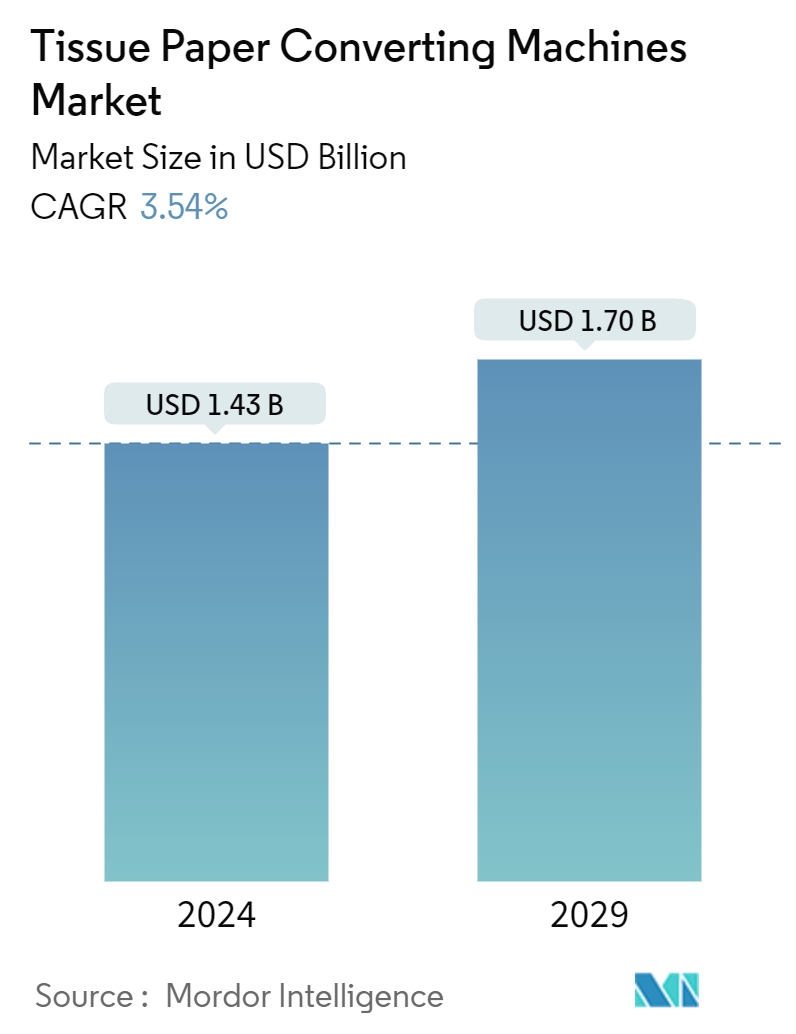Market Size of Tissue Paper Converting Machines Industry

| Study Period | 2019 - 2029 |
| Market Size (2024) | USD 1.43 Billion |
| Market Size (2029) | USD 1.7 Billion |
| CAGR (2024 - 2029) | 3.54 % |
| Fastest Growing Market | Asia Pacific |
| Largest Market | Asia Pacific |
Major Players
*Disclaimer: Major Players sorted in no particular order |
Need a report that reflects how COVID-19 has impacted this market and its growth?
Tissue Paper Converting Machines Market Analysis
The Tissue Paper Converting Machines Market size is estimated at USD 1.43 billion in 2024, and is expected to reach USD 1.70 billion by 2029, growing at a CAGR of 3.54% during the forecast period (2024-2029).
Tissue paper production has a significant impact on the environment. Tissue paper is made from recycled wastepaper and virgin pulp, contributing to greenhouse gas emissions (estimates state that virgin pulp contributes 30% more than wastepaper). With the escalating concerns about environmental sustainability, tissue paper converting equipment manufacturers are extensively implementing green manufacturing models. This includes using recycled materials, reducing water and energy consumption, and adopting processes that minimize environmental impact.
- In tissue paper manufacturing, research and development efforts remain focused on several key areas, including energy saving, fiber saving, final product quality, and the ability to run the machine. The approach flow and headbox area are some of the most energy-intensive stages in tissue-making. Manufacturers are actively exploring new smart options to optimize this area, aiming to achieve better stock homogenization, facilitate quick grade changes, and work toward higher consistencies in the headbox. These efforts are essential for improving overall process efficiency, reducing energy consumption, and enhancing the quality of tissue paper products.
- The integration of smart technology and automation is on the rise, helping to improve overall operational efficiency, reduce waste, and enhance accuracy. Also, the demand for high-speed, fully automated converting lines is expanding, along with rising labor costs and efficiency demands. The fully automatic converting machines reduce waste and the need for human intervention by connecting different processes, such as winding and packaging. Major companies spend heavily on cutting-edge robots, vision, and artificial intelligence-driven optimization as they expand into new manufacturing areas.
- Innovative converting technologies facilitate the efficient utilization of raw materials, particularly paper fibers. Precision cutting and embossing techniques are examples of methods that reduce material waste, while advanced control systems optimize the consumption of water and chemicals during manufacturing.
- The initial investment needed to establish a tissue-converting plant can be substantial, covering expenses like land procurement, building construction or renovation, machinery purchase and installation, and infrastructure development. Much of the capital will be required as working capital, while the cost of machinery and equipment can be as high as 25% or more of the total investment. Securing enough capital for these costs can be tough, especially for small or new businesses. Factors like limited financial resources, perceived risk, and regulatory compliance further complicate the funding process. To address these challenges, businesses may seek partnerships, explore government support programs, develop thorough business plans, and optimize costs to enhance financial viability.
- According to a report published by AFRY (Paper industry specialist) and Suzano (a key global paper and pulp producer), the global consumption of paper is expected to rise to a massive 55 million tons in 2032 from 41 million tons in 2021. This rising demand for tissue paper across the globe would open opportunities for many small and medium-scale producers to enter the tissue paper manufacturing industry, thereby increasing the demand for converting equipment.

